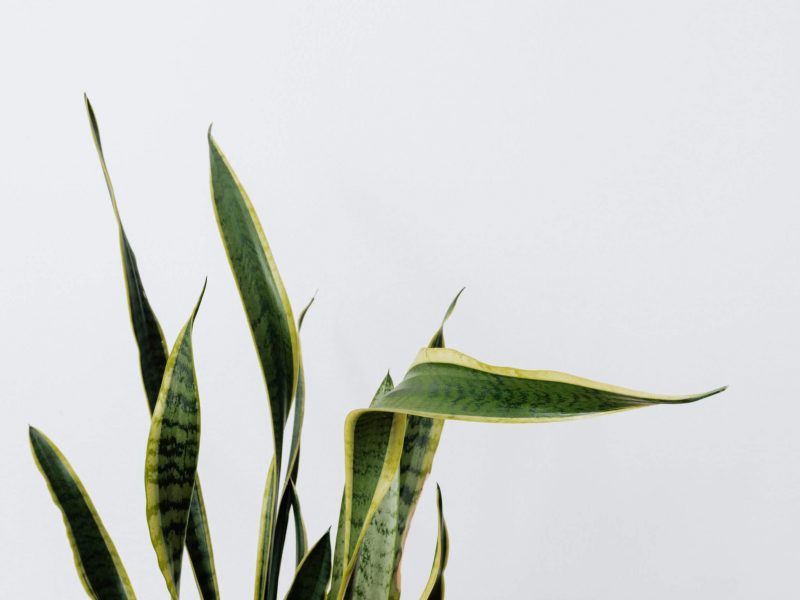
Snake plants are known to be pretty easy to take care of and that is true to a certain extent. They aren’t as sensitive as most other houseplants and will survive well in a range of environments. However, if you notice that your snake plant has begun to develop brown leaves or tips, it could be a sign of unhappiness. The main reasons for this are: underwatering, scarring, overwatering, too much sunlight, over-fertilisation and low humidity.
Top Reasons Why Snake Plants Develop Brown Leaves
Underwatering
If your Snake Plant has developed dry, crispy brown leaves the main cause of this will be underwatering. They don’t like frequent watering and do prefer their soil to be dry. However, going to the other extreme is as damaging for your plant. If you think you have underwatered, take the plant out of its pot and inspect the root system to see what damage has occurred. This will indicate how likely it is for your snake plant to return to normal health. You can also use a moisture meter to determine how much moisture is in the potting mix.
Your first instinct might be to give your plant a tonne of water but this won’t actually fix the problem. Instead, you should begin to water your snake plant little and often. You don’t want to shock it or worse cause the already damaged leaves to rot. Water your plant a little every day for a few days and then space your watering out a little until you are watering only once a fortnight in the growing season.
Scarring
If your snake plant looks rough around the edges and there are brown damaged marks on the sides of the leaves this is often due to scarring.
Snake plants will scar easily if knocked or moved so if your plant is in an area of high traffic in your home this may be the cause. Make sure to move yours away from areas where children and pets can reach it.
Why Snake Plants Can Develop Brown Leaf Tips
Overwatering
Improper watering is one of the biggest issues for most houseplants, and snake plants are no different. Whilst they are definitely a lot less sensitive than other plants, overwatering them can cause some real issues over time.
Snake plants hate it when their soil is too damp and overwatering will cause their leaf tips to brown. During the growth months, you shouldn’t be watering your plant more than once every week or two. During the colder months, once a month is definitely enough. It is really good to get to know your plants as each and every one is ever so slightly different.
As well as checking the moisture at the top of the soil before watering, we also recommend picking up your snake plant before and after watering so you get an idea of much your plant will weigh when it needs water. Be careful that you don’t hurt yourself on the leaf tips when doing this, we are speaking from experience here!
Inconsistent watering
You might find that your snake plant’s leaf tips are turning brown also due to inconsistent watering, rather than simply too much water.
If your plant fluctuates between being waterlogged, to being bone dry, this can cause some real issues for the root system and plant causing brown tips. Just make sure that you stick to a strict watering schedule that reflects the growing and dormant seasons. Again, a moisture meter is great to help you regulate your watering and avoid over or underwatering. A self watering pot like this one will remove all of the guess work!
Too much light
The correct level of sunlight is more important than you think for your Snake Plant. They have a reputation that they can deal with anything from intense sunlight, to shady corners. However, if yours is getting too much direct light, this can cause the leaf tips to turn brown.
Try moving your plant a little further away from the window, or to a slightly shadier spot to avoid further leaf burn. Use a light meter to take away the guessing and make sure that your Snake Plant is getting the perfect amount of sunlight.
Overfertilisation
Most generic plant foods and fertilisers will recommend a dosage for your plants, but it’s often too much for your snake plant and can result in browning of the leaf tips.
It is best to try feeding at half the recommended dosage and see how your snake plant reacts. If you notice any browning you can flush the feed out with more water and try again the next time you water with a quarter of the dosage.
Low humidity
Snake plants like quite humid environments and can struggle in homes with dry air. This can be especially damaging in winter months when we often have the heating on for several hours a day.
A lack of humidity in the air can cause the leaf tips to brown and could eventually begin to affect the whole leaf. If you feel you have quite dry air, make sure to mist your snake plant with a spray bottle every week or so and this should help prevent the plant from drying out.
If you want an even easier solution to humidity problems consider investing in a humidifier as these great little devices can maintain levels in a much simpler way.
One important tip we have to share is that you should never cut off the brown tips. Whilst this is usually fine for a lot of houseplants, this could cause more damage to your snake plant’s leaves as they are very prone to scarring.
To find out more about Snake Plant care, visit our guide. There you will find everything you need to know to keep your Snake Plant healthy and thriving as well as tips and tricks around propagation, fertilisation and repotting.














